- Home
- John Barth
The Friday Book Page 18
The Friday Book Read online
Page 18
The very notion of place, or “setting,” realistically evoked as a main ingredient of fiction, is no doubt as suspect at this hour of the art as are the conventions of realistic characterization or linear plot as practiced by our literary great-grandparents. Our modernist grandparents and parents long since outgrew such parochialism and left us free to choose from three basic attitudes toward the realistic rendition of place in short stories and novels, as toward the other traditional components of prose fiction. I find two of these attitudes regrettable, the third admirable.
First, out of innocence or conservative inclination we may write as though Joyce and Kafka and Beckett and Borges and company had not written—as though the phenomenon of modernism and all that gave rise to it in the history of Western art hadn’t happened, or was a regrettable aberration—and try to carry on where Henry James or Emile Zola or John Galsworthy left off. More Anglo-American writers than not (and about four-fifths of my students) write like this. The attitude strikes me as irresponsible to history, though I acknowledge that it does not preclude good work. A really fine artist can rise above his/her own aesthetics.
Second, we may fall into the opposite error of confusing change in the arts with progress in the empirical sciences, and imagine that because the great modernists turned away from conventional realism, linearity, and continuity, we may never legitimately again paint ravishing nudes, or compose moving melodies, or tell marvelous stories in which are included recognizable places and people. Many of those who practice what is called “meta-fiction” or “sur-fiction” espouse this attitude, and those who misread my 1967 essay “The Literature of Exhaustion” would include me among them. But I deplore this position, too: It is not only sterile and decadent; it’s unintelligent, and it robs the bank of human experience, in which we all have a greater or smaller deposit.
Third, we may regard ourselves as being not irrevocably cut off from the nineteenth century and its predecessors by the accomplishment of our artistic parents and grandparents in the twentieth, but rather as free to come to new terms with both realism and antirealism, linearity and non-linearity, continuity and discontinuity. If the term “postmodern” describes anything worthwhile, it describes this freedom, successfully exercised. It used to be that an unmarried woman was immoral if she said Yes; for a while it seemed she was a prude if she said No; nowadays, she is free not only to say yes or no as she intelligently decides, but to do the asking. Similarly, the “postmodern” writer may find that the realistic, even tender evocation of place (for example) is quite to his purpose, a purpose which may partake of the purposes of both his modernist fathers and his pre-modern remoter ancestors without being quite the same as either’s. The Joyce of Finnegans Wake, after all, is every bit as Irish as Sean O’Casey, without being, like O’Casey, every bit Irish. And Borges explicitly reminds us that one needn’t write about gauchos on the Pampas or the fervor of Buenos Aires to be an Argentine writer.
In his recent book Invisible Cities, Italo Calvino—one of the most appealing of the “postmodernists”—imagines a Marco Polo who describes for a weary Kublai Khan a great many fantastical, no doubt imaginary cities; at one point the Khan observes that perhaps all these invisible cities are variations of Venice: that Marco Polo has never left home.
That is the sort of Landgeist which may still haunt and inspire us in the closing decades of twentieth-century fiction.
Getting Oriented
THE STORIES THUS FAR
PARTLY in order to say hello to William Gass again and to meet his St. Louis colleagues Stanley Elkin and Howard Nemerov, in the September after that spring conjunction in Grand Forks, I went to Washington University in Missouri to address the student body in connection with that university’s undergraduate orientation program. As the date approached, I fixed my imagination duly upon the subject of Orientation—and then learned that what I was really expected to do was read from and chat about my novels and stories.
I wound up more or less reviewing My Fiction Thus Far: a kind of self-orientation prompted by the LETTERS project, which for better or worse—and against my personal shop rules—happened to involve a character from each of my previous six books.
The talk was delivered in Washington U’s Graham Chapel, which is also by way of being Bill Gass’s classroom. So popular a teacher is he, I was told, it is the only hall on campus commodious enough to seat all the students who sign up for his courses.
The LETTERS novel was published in 1979; the project of self-orientation is ongoing. What follows is an amended text of my “orientation lecture,” bringing that project up to date. It appeared in the New York Times Book Review in 1984.
We meet this morning under a mutual misapprehension. You had been led to expect that I would read from and talk about my fiction; I had been led to believe that I’d be addressing the new freshman class as part of their orientation program, and that is what I originally prepared to do. I shall see whether I can do both at once.
As to my orienting university freshpeople to their new academic environment, it is the blind leading the blind. I know very little about Washington University beyond the fact that there are on its faculty at least two excellent writers of fiction and two excellent poets—William Gass, Stanley Elkin, Howard Nemerov, and Mona Van Duyn—all of whom are reported to be fine teachers as well. Enroll in their courses before you graduate. As they are also quite famous, hit them for letters of recommendation for your job-placement files, and you’ll be a shoo-in to graduate school if that is whither you incline. But do this only after you have done brilliant, even astonishing work in their courses; otherwise take your C and don’t be pushy.
That’s all I can think of in the way of specific practical advice for Washington University undergraduates. Speaking more generally, I remind you that orientation literally means determining which way is east, whether for architectural purposes (if you’re building a medieval Christian church, you aim it in that direction, as Graham Chapel is properly aimed) or for funerary purposes (a well-oriented corpse lies with its feet to the rising sun). Apparently it wasn’t until the end of the nineteenth century that orientation came to mean getting one’s bearings, literally or figuratively, and not until well into the twentieth that it was used specifically to name the project of suggesting to new American college students that they’re not high-school kids any longer, but responsible young adults commencing a major phase of their intellectual apprenticeship; taking a tour as it were of the lunchrooms and classrooms, lavatories and laboratories of the Western cultural conglomerate of which Washington University, for example, is one wholly owned subsidiary among many others, and we hope you’ll enjoy your stay here.
In short, the word orientation came to mean finding out where in the occidental world we are as more and more of us came to suspect we didn’t know. I feel on familiar ground. Indeed, when I set about to find something from my fiction suitable for this occasion, I realized that the general project of orientation—at least the condition of disorientation which the project presumes—is my characteristic subject matter, my fictionary stock in trade. Intellectual and spiritual disorientation is the family disease of all my main characters—a disease usually complicated by ontological disorientation, since knowing where you’re at is often contingent upon knowing who you are.
It is a malady, of course, epidemic in the literature of the last hundred years: one of its orientations, you might say, as they use the term in crystallography. What’s more, the specific malaise of academic disorientation I find recurring from book to book of mine like a flu virus one had thought oneself done with. William Carlos Williams remarks in his autobiography that after years and years as both a practicing physician and a practicing poet, it occurred to him one day in a brow-slapping swoop of insight that the word venereal is related to the goddess Venus: It was a connection too obvious for him to have noticed. In the same way, I hadn’t quite realized how academic, in this special sense, my life’s work as a writer of stories has been. All of
my books, I see now, are in the genre the Germans call Erziehungsromane: “upbringing-novels,” education novels—a genre I had not found especially interesting after David Copperfield except as a vehicle for satire or an object of parody. And the satirical and parodical possibilities have been pretty well exhausted too, I’m sure.
More dismaying, when I reviewed my six offspring under this aspect, I realized that what I’ve been writing about all these years is not only orientation and education (rather, disorientation and education), but imperfect or unsuccessful or misfired education at that: not Erziehungsromane but Herabziehungsromane: “down-bringing novels.” That I failed to recognize this before last week is exemplary: I am obliged to reorient myself to my own bibliography, as one must occasionally revise one’s view of oneself retrospectively in the light of some new self-knowledge, usually bad news. And this reorientation is the more timely because my work in progress involves for better or worse the systematic reprise, reorchestration, reorientation of themes and characters from that bibliography: a sure sign that a novelist has passed forty.
The themes of that work in progress, I suppose, are regression, reenactment, and reorientation; like an ox-cart driver in monsoon season or the skipper of a grounded ship, one must sometimes go forward by going back. As an amateur sailor and navigator myself, I like the metaphor of dead reckoning: deciding where to go by determining where you are by reviewing where you’ve been. Aeneas does that, in Carthage and in Hades; many of the wandering heroes of mythology reach an impasse at some crucial point in their journey, from which they can proceed only by a laborious retracing of their steps. This is the process, if not the subject, of my novel-in-regress, and it is the substance of this orientation talk.
Todd Andrews, the hero of my first novel (The Floating Opera), goes to college originally—that is, he enrolls in a particular curriculum in a particular university—in order to fulfill his father’s expectations more than his own. His own expectation is to drop dead before he finishes this sentence, from a certain kind of heart disease he learned he had while serving in the army in World War I. It takes him most of his undergraduate career (and most of a chapter) to discover what on earth he’s doing there in the university; his orientation period, you might say, lasts almost to the baccalaureate. Even postgraduately, he is given to unpredictable shifts of life-style: In successive decades he plays the role of a libertine, an ascetic, a practicing cynic; he ends up at 54 (his present age in the novel) a sexually feeble small-town nihilist lawyer with an ongoing low-grade prostate infection and subacute bacterial endocarditis tending to myocardial infarction, writing long letters to his father, who committed suicide a quarter-century since. The fruit of his education, formal and informal, is one valid syllogism:
1. There is no absolute and ultimate justification for any action.
2. Continuing to live is a variety of action.
3. Therefore etc.
Whence he moves, less validly, to the resolve not only to kill himself that very evening, but to take a goodly number of his townspeople, friends, lovers, and such with him: He means to blow up the showboat of the novel’s title by opening the acetylene gas tanks under the stage that fuel the house and stage lights at landings without electricity. The attempt fails; the show goes on; Todd Andrews’s deductive faculty is restored, perhaps by the gas, and he understands (but neglects to inform Albert Camus) that, given his premises, he’s likely to go on living because there’s finally no more reason to commit suicide than not to.
If this sounds to you like the thinking more of a 24-year-old than of a 54-year-old, that is because the author was 24 at the time. Todd Andrews is a moderately successful lawyer—he lucks out on the two major legal cases in the plot—but he couldn’t have done better than a gentleman’s C+ in Logic 1, and he must have flunked The Chemistry of Gases cold. I hope your education will be more successful.
Novel #2, The End of the Road, is set on and around the campus of a seedy little state teachers college at the opening of the fall term. (In the film version, the campus sequences were shot at Swarthmore, of all inappropriate places: one of the loveliest campuses in the east. This was the first in a series of ruinous mistakes made by the film makers, who, as film makers sometimes do, combined considerable cinematographical expertise with considerable dramaturgical ignorance.) The central character is a grad-school dropout and ontological vacuum named Jacob Horner, who is subject to spells of paralysis because he suffers from the malady cosmopsis, the cosmic view. He is teaching English grammar on orders from his doctor, as a kind of therapy; but the prescription fails, as did his education. He becomes involved with a colleague’s wife, a kind of nature-girl on the wrong trail: Nature may abhor a vacuum, but she shows her abhorrence by rushing to fill it. The novel ends with an illegal and botched abortion fatal to the young woman (this was the 1950s) and a final abdication of personality on Horner’s part. The film critic John Simon accurately remarked that the principal difference between the novel and the film is that whereas the novel concludes with a harrowing abortion, the film is an abortion from start to finish. But I see now that it is Horner’s aborted education that originally wound the mainspring of the plot: his total disorientation in the concourse of Baltimore’s Penn Station, where he first becomes immobilized because he can’t think of any reason to go anywhere—and, apparently, can’t go anywhere without a reason.
Those two novels make a little duet: a nihilist comedy and, if not a nihilist tragedy, at least a nihilist catastrophe. I am a twin—an opposite-sex twin—and I see in retrospect that I’ve been oriented as a writer to the same iteration-with-variation that my sister and I exemplify: a sort of congenital redundancy. There followed a pair of very long novels, The Sot-Weed Factor and Giles Goat-Boy, each of whose heroes begins with a radically innocent orientation of which he is disabused in successive chapters. Ebenezer Cooke, the hero of The Sot-Weed Factor, matriculates at Cambridge University near the end of the seventeenth century; he has been ruinously disoriented by a tutor who professes cosmophilism, the sexual love of everything in the world: men, women, animals, plants, algebra, hydraulics, political intrigue. Cooke, like Jacob Horner, tends toward paralysis; he copes with the tendency by a radical assertion of his innocence and his fondness for versifying: He declares himself programmatically to be a virgin and a poet, as one might choose a double major, and sets out for the New World with a commission as Poet Laureate of the Province of Maryland. But the commission is spurious, his talent is questionable, the New World isn’t what he’d been led to suspect and commissioned to eulogize; his innocence grows ever more technical and imperfect. In the end he has to marry a whore and contract a social disease in order to regain the estate he didn’t recognize as his until he’d lost it. His poetry gets a little better, but it’s written figuratively in red ink—his own blood—and it’s admired for the wrong reasons. By the time he is legitimately appointed Poet Laureate, he couldn’t care less. Ebenezer Cooke would recommend that you choose some other major than Innocence, which he comes to see he has been guilty of.
Giles Goat-Boy, raised by the goats on one of the experimental stock-farms of an enormous, even world-embracing university, takes as his orientation program the myth of the wandering hero: He majors, as it were, in mythic heroism. It is not a gut course, though Giles has to descend into the very bowels of knowledge, and of the Campus, in order to earn his degree. And after nearly 800 pages, the main thing he seems to have learned is that what he’s learned can’t be taught: In his attempts to eff the ineffable, his truths get garbled in transmission, misconstrued, betrayed by verbalization, institutionalization. He almost ceases to care—as, I’m sure, many serious teachers do. But the almost is important.
After those two long books came a pair of short ones, my favorites. Both are about orientation, disorientation, reorientation. Both involve wandering heroes from classical mythology, usually lost. (One reason why classical mythic heroes need to know which way is east is that they traditionally travel west. B
ut they always lose their way.) The first book of the pair is a series of fictions for print, tape, and live voice called Lost in the Funhouse. The title speaks for itself, orientationwise. The other is a series of three novellas, called Chimera. I’ll glance at those novellas briefly through the lens that this occasion has given me, and then we’ll have done.
“Dunyazadiad,” the opening panel of the Chimera triptych, is a reor-chestration of one of my favorite stories in the world: the frame-story of The Thousand and One Nights. You know the tale: how King Shahryar is driven so mad by sexual jealousy that he sleeps with a virgin every night and has her killed in the morning, lest she deceive him; and how that wonderful young woman Scheherazade, the Vizier’s daughter, beguiles him with narrative strategies until he comes to his senses. For a time, I regarded the Nights as an insightful early work of feminist fiction: Scheherazade is called specifically “the Savior of her Sex”; the king’s private misogyny is shown to be dangerous not only to his women but to his own mental health and, since he’s the king, to the public health as well. Later in my own education as a writer, I came to regard the story as a kind of metaphor for the condition of narrative artists in general, and of artists who work on university campuses in particular, for a number of reasons:
1. Scheherazade has to lose her innocence before she can begin to practice her art. Ebenezer Cooke did, too; so do most of us.
2. Her audience—the king—is also her absolute critic. It is “publish or perish,” with a vengeance.
3. And no matter how many times she has pleased the king before, her talent is always on the line. That is as it should be, up to a point, with all of us.

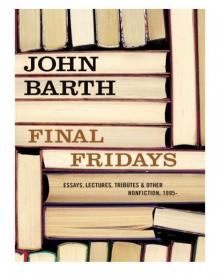 Final Fridays
Final Fridays Where Three Roads Meet: Novellas
Where Three Roads Meet: Novellas Every Third Thought: A Novel in Five Seasons
Every Third Thought: A Novel in Five Seasons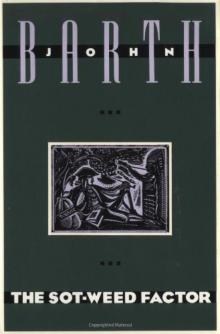 The Sot-Weed Factor
The Sot-Weed Factor The Friday Book
The Friday Book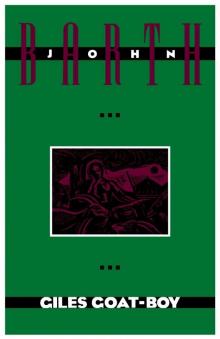 Giles Goat Boy
Giles Goat Boy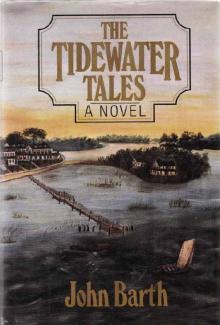 The Tidewater Tales
The Tidewater Tales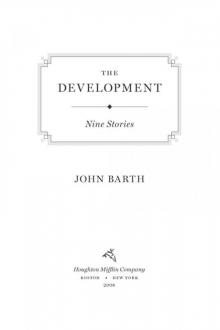 The Development
The Development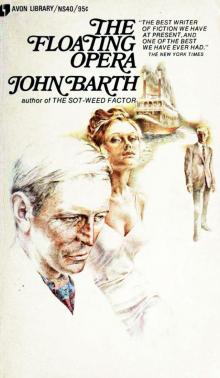 The Floating Opera
The Floating Opera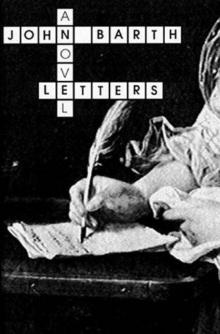 Letters
Letters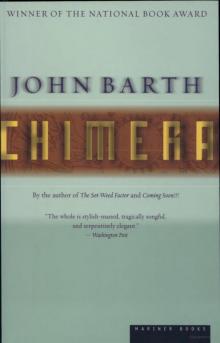 Chimera
Chimera Where Three Roads Meet
Where Three Roads Meet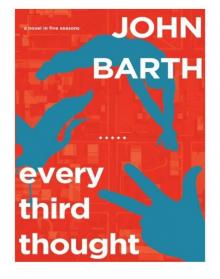 Every Third Thought
Every Third Thought